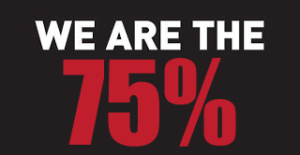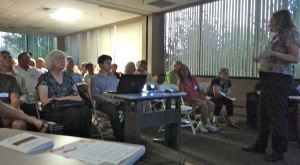On Sunday evening Bill McKibben’s Do the Math tour comes to Boulder to build the movement for weaning ourselves off fossil fuels—and fast. Sold-out crowds are greeting McKibben everywhere, and Boulder will be no exception. Appearing with McKibben is Josh Fox, creator of the film Gasland.
But if you didn’t snag tickets, you can still show your support for leaving fossil fuels in the ground—the only safe place for them if we wish to hand a livable world to our children. Come on Sunday afternoon to a free celebration at Unity Church of Boulder featuring Josh Fox, live music, a silent auction, and more, where you can join with others in “Jamming for a Frack-Free Colorado.”
Though people may think that decreasing fossil fuel use is a utopian, out-of-reach ideal, nothing could be further from the truth. The technology exists to vastly increase our solar power use. We lag behind certain other countries in creation and use of photovoltaic and other solar energy systems. The jobs created in building a solar infrastructure would be welcome in this economy. The amount of long-term and irreversible damage to the atmosphere and ecosystem saved by abandoning fossil fuel extraction would be enormous. The only thing lacking is commitment.
And information. Because most of us know so little about solar options, I’m going to feature solar energy in upcoming posts. This first piece is by my friend Rosana Francescato, whom I got to know a long time ago when we were both copy editors. Rosana volunteers for a Bay Area nonprofit, GRID Alternatives, in their annual summer Solarthon, installing solar panels on the homes of low-income people. As she says in her fund-raising video, “Just one typical GRID installation prevents 95 tons of greenhouse gas emissions. That’s like planting 272 trees!”
Rosana also called my attention to a new law making possible community solar projects here in Colorado (and she’s working for a similar law in California). Through subscribing to a solar garden, people who don’t own their homes can still enjoy the planet-saving and cost-saving benefits of going solar. The Colorado law went into effect earlier this year, and the first community solar projects are under way.
Here is Rosana on solar for hard-to-reach roofs. Did you know all this was happening in solar energy? I didn’t!
SOLAR FOR THE 75%
by Rosana Francescato
By definition,  most of us are in the 99%. Some of us may even be in that mythical 47%. But there’s another group that many of us are in, without even being aware of it: the 75%. That’s the estimated number of people who can’t get solar on their roof.
most of us are in the 99%. Some of us may even be in that mythical 47%. But there’s another group that many of us are in, without even being aware of it: the 75%. That’s the estimated number of people who can’t get solar on their roof.
While leases are helping far more people go solar than before, 75% of us are still left out of the equation. We may have shaded roofs, rent our homes, or live in multi-unit buildings. And these are just a few of the reasons preventing so many of us from going solar.
But don’t despair! There’s hope for the 75%, and plenty of it. The boom happening right now in community solar is making it possible for almost anyone to benefit from solar power. At a recent Community Solar Forum put on by Solar Sonoma County, the 75% became a theme as we learned about some of the options:
- Community Choice Energy: Programs like Sonoma Clean Power and CleanPowerSF are enabling utility customers in some areas to buy their power from renewable sources.
- Solar Gardens: Some states have laws that allow virtual net metering, which lets utility customers subscribe to solar power from an installation not on their own roof. [Colorado readers: that’s us! The new law went into effect this year.]
- CLEAN programs, or feed-in tariffs: By promoting these programs, the Clean Coalition is working toward the goal for 2020 of 80% of all new electricity generation in the United States coming from renewable energy sources.
- Co-ops: Energy co-ops like the San Francisco Energy Cooperative allow anyone to participate in solar for as little as $50. They hope to be a model for other co-ops around the country.
The speakers at the forum all had slightly different perspectives, and they were focused on different ways to bring solar to communities. But they all shared the goal of helping as many people as possible to participate in renewable energy—that is, reaching the 75%.
All of these ways to bring solar to the 75% are important and highly effective — and even affordable. Models like community choice energy, solar gardens, and CLEAN programs generally result in savings, especially over time. They bring a slew of other benefits, like cleaner air, local jobs, increased national security. So it’s crucial to support these efforts. Still, while a lot is happening already, some of these programs can take years to implement, and they aren’t yet available everywhere.
In the meantime, how do we get the word out to the 75% that there are options for them—for us—now?
For most people, that will mean an appeal to their pocketbook. Those with an active interest in supporting solar for altruistic reasons are a minority. But most people like the idea of saving money or getting a good return on an investment. If they can do good at the same time, that’s a nice benefit.
And now there are more ways to invest in solar and do well while doing good. Energy co-ops can already provide a return on small investments, and the JOBS Act should allow for larger investments in the near future. Other organizations use crowdfunding models where people can move from recouping their investment to receiving a return on that investment. For example, Mosaic allows people to invest in solar projects and get paid back from the clean energy produced.
There’s more coming, so stay tuned! Before long, we’ll have solar for the 75%. To learn more about community solar, check out the following:
- Sign up to be notified when Mosaic launches a new way to crowdfund solar for communities at www.joinmosaic.com.
- Check out sites on solar gardens, community choice and CLEAN programs, and community power to see how you can support their efforts and what you can do in your community.
- Join the Vote Solar Initiative to find out how to support solar legislation around the country. They also provide free webinars on solar topics.
